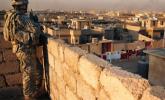 |
 |
Operation Phantom Phoenix
Operation Phantom Phoenix began in the first week of January 2008. According to Lt. Gen. Raymond T. Odierno, the goal for Operation Phantom Phoenix, was to protect the nine major cities in Iraq, with a particular emphasis on Baghdad. This was also the case with the previous Corps level offensives, Operation Phantom Thunder and Operation Phantom Strike. Phantom Thunder ran from June to August last year and aimed to eliminate major enemy safe havens around the capital in order to secure the population of
Operation Phantom Phoenix aimed to destroy the remaining al-Qaeda in Iraq presence and was expected to last between 60 and 90 days. Lt. Gen Odierno stated: “Working closely with the Iraqi Security Forces, we will continue to pursue al-Qaeda and other extremists wherever they attempt to take sanctuary.” These operations aim to eradicate safe havens and focus on territories in MND-North’s area of operations, including the Diyala River Valley and Ninevah province.
Phantom Phoenix included several joint Iraqi and Coalition division and brigade-level operations throughout northern Iraq (MND-North’s area of operations) as well as in the southern belts of Baghdad (MND-Central’s area of operations). In MND-North, Operation Iron Harvest is the division-level operation, while in MND-South the division-level operation is Operation Marne Thunderbolt.
Additionally, Phantom Phoenix went after car, truck and suicide bomb networks in Baghdad as well as al-Qaeda’s financial network. Following kinetic operations that cleared areas, Coalition and Iraqi forces built combat outposts and joint security stations into those places and then followed with CERP funds to improve governance and grow the local economy.
Phantom
In the first three weeks of Phantom Phoenix 18 battalion-level operations were conducted detaining 1,023 terrorists and killing 121 others. By the end of the operation, 900 insurgents had been killed and 2,500 captured. Among those captured or killed were 92 high value targets. In addition, 351 weapons caches, 410 improvised explosive devices, three vehicle bomb and improvised explosive device factories, and four tunnel complexes were all found and cleared.
